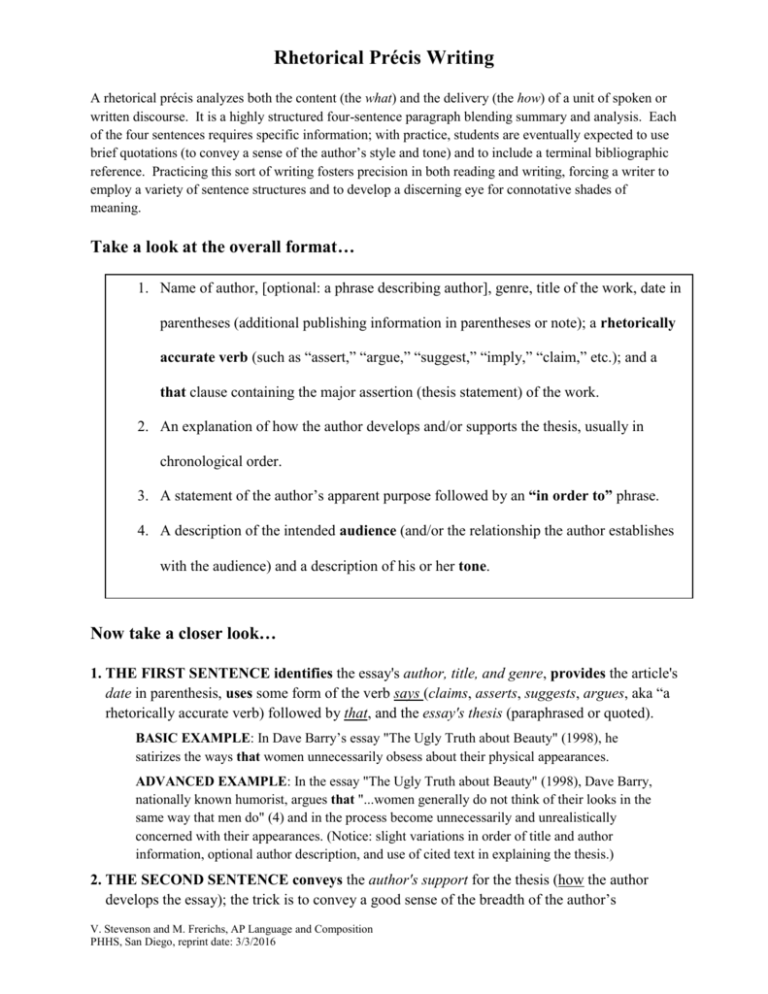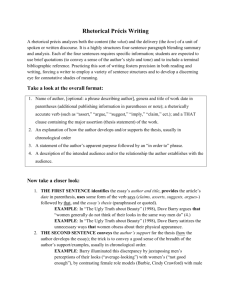Now take a closer look…
advertisement

Rhetorical Précis Writing A rhetorical précis analyzes both the content (the what) and the delivery (the how) of a unit of spoken or written discourse. It is a highly structured four-sentence paragraph blending summary and analysis. Each of the four sentences requires specific information; with practice, students are eventually expected to use brief quotations (to convey a sense of the author’s style and tone) and to include a terminal bibliographic reference. Practicing this sort of writing fosters precision in both reading and writing, forcing a writer to employ a variety of sentence structures and to develop a discerning eye for connotative shades of meaning. Take a look at the overall format… 1. Name of author, [optional: a phrase describing author], genre, title of the work, date in parentheses (additional publishing information in parentheses or note); a rhetorically accurate verb (such as “assert,” “argue,” “suggest,” “imply,” “claim,” etc.); and a that clause containing the major assertion (thesis statement) of the work. 2. An explanation of how the author develops and/or supports the thesis, usually in chronological order. 3. A statement of the author’s apparent purpose followed by an “in order to” phrase. 4. A description of the intended audience (and/or the relationship the author establishes with the audience) and a description of his or her tone. Now take a closer look… 1. THE FIRST SENTENCE identifies the essay's author, title, and genre, provides the article's date in parenthesis, uses some form of the verb says (claims, asserts, suggests, argues, aka “a rhetorically accurate verb) followed by that, and the essay's thesis (paraphrased or quoted). BASIC EXAMPLE: In Dave Barry’s essay "The Ugly Truth about Beauty" (1998), he satirizes the ways that women unnecessarily obsess about their physical appearances. ADVANCED EXAMPLE: In the essay "The Ugly Truth about Beauty" (1998), Dave Barry, nationally known humorist, argues that "...women generally do not think of their looks in the same way that men do" (4) and in the process become unnecessarily and unrealistically concerned with their appearances. (Notice: slight variations in order of title and author information, optional author description, and use of cited text in explaining the thesis.) 2. THE SECOND SENTENCE conveys the author's support for the thesis (how the author develops the essay); the trick is to convey a good sense of the breadth of the author’s V. Stevenson and M. Frerichs, AP Language and Composition PHHS, San Diego, reprint date: 3/3/2016 support/examples, usually in chronological order. BASIC EXAMPLE: Barry develops his ideas by juxtaposing men's perceptions of their looks with women's, contrasting male and female role models, and comparing men's interests with women's. ADVANCED EXAMPLE: Barry illuminates this discrepancy by juxtaposing men's perceptions of their looks ("average-looking") with women's ("not good enough"), by contrasting male role models (He-Man, Buzz-Off) with female role models (Barbie, Cindy Crawford), and by comparing men's interests (the Super Bowl, lawn care) with women's (manicures). (Notice: more sophisticated vocabulary and use of both direct and indirect citations of text in support of ideas.) 3. THE THIRD SENTENCE analyzes the author's purpose using an in order to statement: BASIC EXAMPLE: Using examples from popular culture, he exaggerates and stereotypes these differences in order to poke fun at a social norm and encourage women to rethink their acceptance of these social expectations ADVANCED EXAMPLE: Using examples from popular culture (the Oprah show, Brad Pitt), he exaggerates and stereotypes these differences in order to prevent women from so eagerly accepting society's expectation of them; in fact, Barry claims that men who want women to "look like Cindy Crawford" are "idiots" (10). (Notice: fuller analysis of author’s purpose, direct citation of text, and compound complex sentence structure.) 4. THE FOURTH SENTENCE describes the essay's target audience and characterizes the author's relationship with that audience—and addresses the essay's tone: BASIC EXAMPLE: Barry opens and closes the essay by directly addressing men ("If you're a man...”) and offering to give them advice, but his actual audience is both men and women, whom he addresses with a warm but mocking tone. ADVANCED EXAMPLE: Barry’s ostensible audience is men because he opens and closes the essay by directly addressing men ( "If you're a man...”) and offering to give them “advice” in a mockingly conspiratorial tone; however, by using humor to poke fun at both men and women’s perceptions of themselves, Barry makes his essay palatable to both genders and hopes to convince women to stop obsessively "thinking they need to look like Barbie" (8). Put it all together and it looks darn smart! BASIC EXAMPLE In Dave Barry’s essay "The Ugly Truth about Beauty" (1998), he satirizes the ways that women unnecessarily obsess about their physical appearances. Barry develops his ideas by juxtaposing men's perceptions of their looks with women's, contrasting male and female role models, and comparing men's interests with women's. Using examples from popular culture, he exaggerates and stereotypes these differences in order to poke fun at a social norm and encourage women to rethink their acceptance of these social expectations. Barry opens and closes the essay by directly addressing men ("If you're a man...”) and offering to give them advice, but his actual audience is both men and women, whom he addresses with a warm but mocking tone. Word Count: 116 2 ADVANCED EXAMPLE: In the essay "The Ugly Truth about Beauty" (1998), Dave Barry, nationally known humorist, argues that "...women generally do not think of their looks in the same way that men do" (4) and in the process become unnecessarily and unrealistically concerned with their appearances. Barry illuminates this discrepancy by juxtaposing men's perceptions of their looks ("average-looking") with women's ("not good enough"), by contrasting male role models (He-Man, Buzz-Off) with female role models (Barbie, Cindy Crawford), and by comparing men's interests (the Super Bowl, lawn care) with women's (manicures). Using examples from popular culture (the Oprah show, Brad Pitt), he exaggerates and stereotypes these differences in order to prevent women from so eagerly accepting society's expectation of them; in fact, Barry claims that men who want women to "look like Cindy Crawford" are "idiots" (10). Barry’s ostensible audience is men because he opens and closes the essay by directly addressing men ( "If you're a man...”) and offering to give them “advice” in a mockingly conspiratorial tone; however, by using humor to poke fun at both men and women’s perceptions of themselves, Barry makes his essay palatable to both genders and hopes to convince women to stop obsessively "thinking they need to look like Barbie" (8). Word count: 205 Barry, Dave. "The Ugly Truth about Beauty." Mirror on America: Short Essays and Images from Popular Culture. 2nd ed. Eds. Joan T. Mims and Elizabeth M. Nollen. NY: Bedford, 2003. 109-12 Verb Bank Here is a list of verbs you might find helpful. It is by no means a required or exhaustive list. Always strive to employ the most connotatively precise words you can. adjures advances advises asks asserts begs beseeches cajoles cheers chimes commands complains confides conveys counsels crows declares decrees decries demands describes dictates directs discloses divulges elucidates employs encourages entreats espouses exclaims exhorts explains gripes groans grouses grumbles hails hints illustrates implies implores inquires insinuates instructs intimates invokes justifies laments mandates mocks muses orders pleads ponders pontificates proclaims pronounces proposes queries rationalizes recommends recounts relates reports requests reveals sighs sings snarls sneers states submits suggests summons wails whimpers whines wields wonders 3








